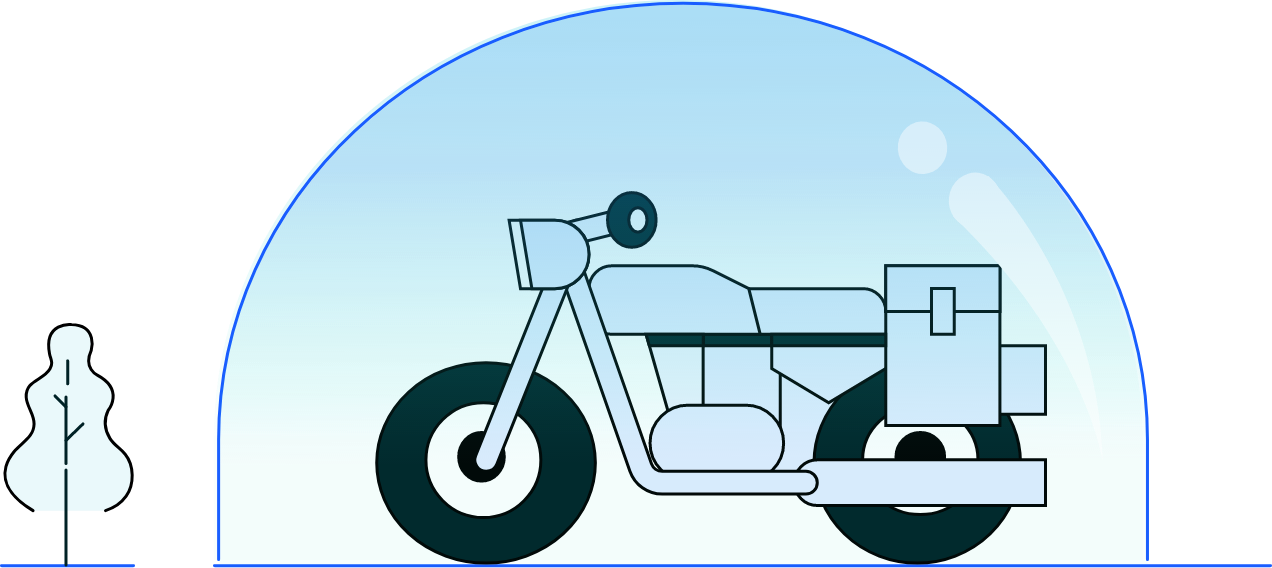How To Find The VIN, Chassis Number & Engine Number Of Your Bike
Have you ever wondered about the hidden codes containing crucial information about your two-wheeled companion? We are talking about the Vehicle Identification Number (VIN) and Chassis Number in bikes, which act as an exclusive fingerprint for your bike.
Whether you are a passionate rider, a conscientious buyer, or simply curious about the inner workings of your beloved machine, understanding how to locate and decode these numbers can provide invaluable insights.
In this blog, we will take a captivating journey to uncover the mystery behind your bike's VIN and Chassis Number. We will explore why these alphanumeric codes are so important, what information they reveal, and how you can easily locate them on your motorcycle.
From deciphering manufacturing details to identifying your bike's history, we will equip you with the knowledge to demystify these hidden identifiers.
So, let’s get started!
Share this article
Protect Your Ride with the Best Bike Insurance Plans
Comprehensive, Third Party And Own Damage Bike Insurance At Tempting Premium

List of Content
- What is VIN or Vehicle Identification Number?
- The Inception of VIN – A Brief History
- Where to Find Chassis Number of a Bike or its VIN?
- Are VIN and Chassis Number the Same?
- What are the Common Components of a Bike VIN?
- What is the Engine Number of a Bike, and What is the CC?
- Where to Find the Bike’s Engine Number?
- Does the CC of a Bike Affect the Insurance Premium?
- To Sum it Up
What is VIN or Vehicle Identification Number?
A Vehicle Identification Number (VIN) is a unique alphanumeric code assigned to each vehicle. Acting as a digital fingerprint, the VIN is an essential identifier for automobiles, including motorcycles.
Comprising a series of characters, the VIN holds vital information about the vehicle's manufacturer, model, year of production, and specific features. It serves multiple purposes, such as aiding in vehicle registration, tracking recalls, facilitating insurance claims, and providing a means to verify the authenticity and history of a vehicle.
Understanding the significance of a VIN empowers owners, buyers, and authorities to access essential details about a bike, ensuring transparency and enhancing overall safety and security within the automotive industry.
The Inception of VIN – A Brief History
The Vehicle Identification Number (VIN) concept can be traced back to the early 1950s when the automotive industry recognized the need for a standardised system to identify and track vehicles uniquely. The primary purpose of introducing the VIN was to enhance vehicle safety, improve vehicle theft prevention, and facilitate accurate vehicle identification for various administrative and legal purposes.
The U.S. National Highway Traffic Safety Administration (NHTSA) initially developed the VIN system in collaboration with the International Organization for Standardization (ISO) to establish a uniform identification method for vehicles worldwide. The standardised VIN system was first introduced in the United States in 1954 and gradually adopted by other countries.
Since its inception, the VIN has expanded to include information beyond basic identification, such as manufacturing plant codes, production year, and vehicle attributes. Today, the VIN is a unique identifier for automobiles, motorcycles, and other motor vehicles, allowing for accurate tracking, recall management, and vehicle history reporting.
Where to Find Chassis Number of a Bike or its VIN?
The location of the Vehicle Identification Number (VIN) or chassis number bike can vary depending on the manufacturer and model.
Here are some common places to find the VIN or chassis number on a bike:
Frame: The bike VIN number or chassis number is often stamped or etched into the bike's frame. Look for a metal plate or a series of numbers and letters directly on the frame, typically on the steering head (where the front forks attach to the frame) or on the frame near the engine.
Fork neck: On some bikes, the VIN or chassis number may be located on the fork neck, part of the frame that connects the front forks and the frame itself. Look for a metal plate or a stamped number in this area.
Engine: In some cases, the VIN or chassis number may be on the bike's engine. Check the engine casing or other visible parts of the engine for a stamped or engraved number.
Owner's manual or documents: The VIN or chassis number may also be listed in the owner's manual or other documents that came with the bike. Check any paperwork you have for the bike to see if the number is listed there.
Are VIN and Chassis Number the Same?
Yes, the terms "Vehicle Identification Number" (VIN) and "Chassis Number" are often used interchangeably and refer to the same unique identifier for a vehicle. Both VIN and two-wheeler Chassis Number serve as alphanumeric codes that provide crucial information about the vehicle's manufacturer, model, production year, and other specific details.
What are the Common Components of a Bike VIN?
A typical Vehicle Identification Number (VIN) for a bike consists of a series of alphanumeric characters that provide specific information about the bike's manufacturer, model, and other details. While the exact format can vary depending on the manufacturer and country, here is a general breakdown of the components of a bike's VIN
World Manufacturer Identifier (WMI) The first three characters represent the WMI, which identifies the manufacturer and the country of origin of the motorcycle. It is a unique code assigned to each manufacturer.
Vehicle Descriptor Section (VDS) The next six characters provide information about the bike's characteristics, such as the model, engine type, and body style.
Vehicle Identifier Section (VIS) The remaining characters in the VIN make up the VIS, providing a unique serial number the manufacturer assigns to the specific bike. This section can include numbers and letters.
What is the Engine Number of a Bike, and What is the CC?
The Engine Number of a bike is a unique alphanumeric code assigned to the motorcycle's engine. It is an identification number specific to the engine unit, separate from the Vehicle Identification Number (VIN) that identifies the entire bike. The Engine Number helps accurately identify the engine and is often required for documentation, registration, and maintenance purposes.
In the context of motorcycles, CC refers to the engine's displacement or cubic capacity. It stands for "Cubic Centimetres" and represents the total volume of all the cylinders in the engine. It is a unit of measurement that indicates the size or capacity of the engine.
Engine displacement or CC is commonly used to categorise and classify motorcycles. Motorcycles with higher CC values generally have more power and performance capabilities. However, it's important to note that a motorcycle's power output and performance are influenced by various factors, such as engine design, technology, and tuning, in addition to the CC value.
Where to Find the Bike’s Engine Number?
The bike's engine number can typically be engraved or stamped on the engine casing or block. It is often located on the side or bottom of the engine, near the crankcase or cylinder head. Referencing the bike's user manual and registration certificate or contacting the manufacturer can provide specific guidance on locating the engine number for a particular model.
Does the CC of a Bike Affect the Insurance Premium?
Yes, a bike's cubic capacity (CC) can affect the bike insurance policy premium. Higher CC bikes are generally associated with higher premiums due to increased power, the potential for higher speeds, and potentially higher repair or replacement costs.
For example, let's consider two bikes:
Bike A has a 150cc engine.
Bike B has a 600cc engine.
Given similar profiles for the riders, such as age, experience, and location, the insurance premium for Bike B with a higher CC is likely to be higher than that of Bike A. Bike B is considered more powerful and may have a higher risk of accidents or potential damage.
Insurance companies determine premium rates based on various factors, including the risk profile of the insured vehicle. Higher CC bikes are often associated with a higher risk of accidents or repair costs, which can increase premiums.
Also, multiple factors influence insurance for 2-wheeler premiums, and CC is just one aspect. The make, model, age of the bike, and the specific insurance provider's underwriting criteria will also play a role in determining the final premium amount.
With Tata AIG, you can easily compare two-wheeler insurance premiums and pick the best suited to your insurance goals.
To Sum it Up
Ensuring your bike's safety involves finding the VIN and chassis number and having a robust bike insurance plan. These numbers aid in identification and documentation, while insurance provides financial protection against accidents, theft, and damages.
A comprehensive bike insurance plan is essential to safeguard your valuable asset, providing peace of mind and alleviating potential financial burdens. Tata AIG offers comprehensive bike policies, delivering extensive coverage, seamless claim settlement, and exceptional customer service.
Choose us for our trusted expertise in providing comprehensive protection for your vehicle.
Protect Your Ride with the Best Bike Insurance Plans
Comprehensive, Third Party And Own Damage Bike Insurance At Tempting Premium
Share this article
Latest from our blogs

5 Tips To Keep Your Two Wheeler Looking New
Make sure to wash it often. This keeps dirt and other unwant...
Read More
What Does It Take to Be a Good Biker?
You must have wondered what it takes to become a better ride...
Read More
5 Things You Did Not Know About Two Wheeler Insurance
In a time of heavy traffic and accidents, two wheeler insura...
Read More